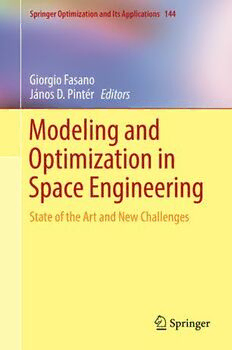Table Of ContentSpringer Optimization and Its Applications 144
Giorgio Fasano
János D. Pintér Editors
Modeling and
Optimization in
Space Engineering
State of the Art and New Challenges
Springer Optimization and Its Applications
Volume 144
ManagingEditor
PanosM.Pardalos ,UniversityofFlorida
Editor-CombinatorialOptimization
Ding-ZhuDu,UniversityofTexasatDallas
AdvisoryBoard
J.Birge,UniversityofChicago
S.Butenko,TexasA&MUniversity
F.Giannessi,UniversityofPisa
S.Rebennack,KarlsruheInstituteofTechnology
T.Terlaky,LehighUniversity
Y.Ye,StanfordUniversity
AimsandScope
Optimizationhasbeenexpandinginalldirectionsatanastonishingrateduringthe
lastfewdecades.Newalgorithmicandtheoreticaltechniqueshavebeendeveloped,
thediffusionintootherdisciplineshasproceededatarapidpace,andourknowledge
ofallaspectsofthefieldhasgrownevenmoreprofound.Atthesametime,oneof
themoststrikingtrendsinoptimizationistheconstantlyincreasingemphasisonthe
interdisciplinarynatureofthefield.Optimizationhasbeenabasictoolinallareas
ofappliedmathematics,engineering,medicine,economicsandothersciences.
The series Springer Optimization and Its Applications publishes undergraduate
and graduate textbooks, monographs and state-of-the-art expository works that
focusonalgorithmsforsolvingoptimizationproblemsandalsostudyapplications
involvingsuchproblems.Someofthetopicscoveredincludenonlinearoptimization
(convex and nonconvex), network flow problems, stochastic optimization, optimal
control, discrete optimization, multi-objective programming, description of soft-
warepackages,approximationtechniquesandheuristicapproaches.
Moreinformationaboutthisseriesathttp://www.springer.com/series/7393
Giorgio Fasano • János D. Pintér
Editors
Modeling and Optimization
in Space Engineering
State of the Art and New Challenges
123
Editors
GiorgioFasano JánosD.Pintér
ThalesAleniaSpace DepartmentofIndustrialand
Turin,Italy SystemsEngineering
LehighUniversity
Bethlehem,PA,USA
ISSN1931-6828 ISSN1931-6836 (electronic)
SpringerOptimizationandItsApplications
ISBN978-3-030-10500-6 ISBN978-3-030-10501-3 (eBook)
https://doi.org/10.1007/978-3-030-10501-3
LibraryofCongressControlNumber:2019935527
Mathematics Subject Classification: 05B40, 37N05, 37N40, 49-06, 65K05, 70M20, 90Bxx, 90-08,
90C11,90C26,90C29,90C30,90C90
©SpringerNatureSwitzerlandAG2019
Thisworkissubjecttocopyright.AllrightsarereservedbythePublisher,whetherthewholeorpartof
thematerialisconcerned,specificallytherightsoftranslation,reprinting,reuseofillustrations,recitation,
broadcasting,reproductiononmicrofilmsorinanyotherphysicalway,andtransmissionorinformation
storageandretrieval,electronicadaptation,computersoftware,orbysimilarordissimilarmethodology
nowknownorhereafterdeveloped.
Theuseofgeneraldescriptivenames,registerednames,trademarks,servicemarks,etc.inthispublication
doesnotimply,evenintheabsenceofaspecificstatement,thatsuchnamesareexemptfromtherelevant
protectivelawsandregulationsandthereforefreeforgeneraluse.
Thepublisher,theauthors,andtheeditorsaresafetoassumethattheadviceandinformationinthisbook
arebelievedtobetrueandaccurateatthedateofpublication.Neitherthepublishernortheauthorsor
theeditorsgiveawarranty,expressorimplied,withrespecttothematerialcontainedhereinorforany
errorsoromissionsthatmayhavebeenmade.Thepublisherremainsneutralwithregardtojurisdictional
claimsinpublishedmapsandinstitutionalaffiliations.
ThisSpringerimprintispublishedbytheregisteredcompanySpringerNatureSwitzerlandAG.
Theregisteredcompanyaddressis:Gewerbestrasse11,6330Cham,Switzerland
Preface
Two edited volumes dedicated to the challenging and wide-ranging subject of
optimizationinspaceengineeringhavebeenrecentlypublished:
Fasano and Pintér, Eds., Modeling and Optimization in Space Engineering,
Springer,2013
FasanoandPintér,Eds.,SpaceEngineering:ModelingandOptimizationwithCase
Studies,Springer,2016
Thestronginteresttowardsthetopicscoveredbytheseworkshasmotivatedthe
thirdtopicalbookprojectthathasledtothepresentvolume.
Spaceengineeringtasksfrequentlyrequiretheanalysisandsolutionofadvanced
and often very hard optimization problems. In the earliest studies, the primary
concern was related to the viability of the mission to accomplish. Therefore
optimizationgenerallyfocusedonmissionanalysisaspects,withspecificattention
to technical feasibility and mission safety. Space engineering projects typically
required the analysis and optimization of trajectories and fuel consumption, with
paramountconsiderationgiventocrewprotection.
As time has passed, commercial interests and implied cost-efficiency aspects
related to space projects have become increasingly important. A well-known
example – in apparent need of complex cost-benefit and risk analysis studies – is
thecontinuingoperationoftheInternationalSpaceStation.
For current and forthcoming space engineering projects, today’s higher envi-
ronmental awareness imposes mission constraints that in the past were sim-
ply (or almost) neglected. The ambitious goals of future interplanetary explo-
rations–specificallyincludingmannedmissions–willrequireadvancedanalytical
approaches to guarantee safety, to maximize the performance of the systems
adopted,andtomakeuseofmissionresourcesasefficientlyaspossible.
Currentoptimizationissuesarerelatedtoabroadrangeofchallengesincluding,
e.g.low-thrusttransfers,interplanetarytrajectories,transferstonear-Earthobjects,
safety analysis of possible collision with space debris, re-entry vehicles, hybrid
rocket engines, robust spacecraft design, on-board task scheduling, cargo loading
v
vi Preface
and packing, payload accommodation with balancing conditions, and satellite
constellationimageacquisition.
While the necessary depth and quality of the decisions required by space
engineering projects has been increasing, we have also witnessed continuing
innovation regarding theoretical advances and practical (ready-to-use) decision
supporttoolsforsuchapplications.Theresultsofscientificinnovation,modelling,
and algorithmic developments are supported and enhanced by today’s advanced
computationalmodellingandoptimizationenvironments.Startingfromtheearliest
space engineering applications, the solution of increasingly hard optimization
problems has become necessary. Until fairly recent times, numerical optimization
approacheswerelimitedtohandlinglinearorconvexnonlinearcontinuousmodels,
aswellasintegerlinearormixedinteger-continuouslinearoptimizationproblems.
Recentadvancesintheareaofoptimizationsupportalsothehandlingofnon-convex
problemformulations:thisdevelopmentenablesthesolutionofmorerealistic–but
oftenmuchharder–optimizationproblems.
The present volume consists of 17 contributed chapters. Written by leading
experts, the book offers in-depth discussions of the mathematical modelling and
algorithmicaspectsoftacklingabroadrangeofspaceengineeringapplications.
Specific mission analysis and attitude control subjects include the following:
optimallaunchdateanalysisforinterplanetarymissions,evolutionaryneuro-control
for the global optimization of continuous-thrust trajectories,machine learning and
evolutionary optimization techniques for interplanetary trajectory design, optimal
finite-thrust orbital transfers, single-stage-to-orbit space-plane trajectory perfor-
manceanalysis,ascenttrajectoryoptimizationandneighbouringoptimalguidance
of multistage launch vehicles, catalogue generation of parametric time-optimal
transfersforall-electricgeostationarysatellites,real-timeoptimalcontroldedicated
tools, advanced numerical strategies for sensitivity analysis and reliability assess-
mentofalauncherstagefalloutzone,evidence-basedrobustoptimizationofpulsed
laser orbital debris removal, simulation and attitude determination, and control of
smallsatellites.
Systemdesignandconfigurationaspectsarediscussedinseveralchapters.Topics
include the general problem of control dispatch optimization in a spacecraft and
a real-world application in the framework of the European Space Agency’s Next
Generation Gravity Mission, packing problems with balancing conditions, and
the optimal topological design of a thermal insulator for a monopropellant space
thruster. The analysis of observation planning and scheduling aspects in multiple
heterogeneoussatellitemissionsalsobelongstothisgroupofstudies.
Thisbookwillbeofinterestforresearchersandpractitionersworkinginthefield
of space engineering. Since it offers an in-depth exposition of the mathematical
modelling and algorithmic and numerical solution aspects of the topics covered,
the book will be useful also for aerospace engineering graduate and post-graduate
studentswhowishtoexpandupontheirknowledge,bystudyingreal-worldapplica-
tionsandchallengesthattheywillmeetintheirprofessionalwork.Thecontributed
chaptersarefocusedonspaceengineeringpractice,ratherthanontheory.Withthis
aspect in mind, researchers and practitioners in mathematical systems modelling,
Preface vii
operations research, optimization, and optimal control will also benefit from the
casestudiespresentedinthiswork.
The model development and optimization approaches discussed in the book
can be extended also towards other application areas that are not related to space
engineering. Hence, the book can be a useful reference to assist the development
of new applications. Readers will obtain a broad overview of some of the most
challenging space engineering operational scenarios of today and tomorrow: this
aspect will benefit managers in the aerospace field, as well as in other industrial
sectors.
Turin,Italy GiorgioFasano
Bethlehem,PA,USA JánosD.Pintér
Acknowledgements
Firstandforemost,wewishtothankallAuthorsfortheirhigh-qualitycontribution
andfortheirdedicatedefforttomakethetimelycompletionandpublicationofthis
bookpossible.
We are grateful to our colleagues who assisted us with valuable peer reviews
of the contributed chapters. We wish to express our special thanks to Mathieu
Balesdent,LorenzoCasalino,SimoneCeccherini,KaiWahChan,BerndDachwald,
GiancarloGenta,MarcelJacobse,MatthiasKnauer,RenkeKuhlmann,ErwinMooij,
JérômeMorio,MauroPontani,KaiSchäfer,MarkSenez,andFrancescoTopputo.
One of the editors (GF) thanks also Walter Cugno and Roberto Angelini of
ThalesAleniaSpace(Turin,Italy)fortheirsupportoftheresearchanddevelopment
activities related to modelling and optimization in a range of space engineering
applications.
We have been glad to work with Razia Amzad, our book project Editor at
Springer, Vinodhini Srinivasan, and the entire Springer production team on this
project,fromitsinitialdiscussiontoitscompletion.Welookforwardtocontinuing
cooperation.
ix
Contents
Preface............................................................................. v
Acknowledgements............................................................... ix
Control Propellant Minimization for the Next Generation
GravityMission .................................................................. 1
Alberto Anselmi, Stefano Cesare, Sabrina Dionisio, Giorgio Fasano,
andLucaMassotti
Global Optimization of Continuous-Thrust Trajectories Using
EvolutionaryNeurocontrol...................................................... 33
BerndDachwaldandAndreasOhndorf
NonparametricImportanceSamplingTechniquesforSensitivity
AnalysisandReliabilityAssessmentofaLauncherStageFallout.......... 59
PierreDerennes,VincentChabridon,JérômeMorio,MathieuBalesdent,
FlorianSimatos,Jean-MarcBourinet,andNicolasGayton
DynamicSystemControlDispatch:AGlobalOptimizationApproach.... 87
GiorgioFasano
ChoiceoftheOptimalLaunchDateforInterplanetaryMissions .......... 111
GiancarloGentaandP.FedericaMaffione
Optimal Topological Design of a Thermal Isolator
foraMonopropellantSpaceThruster......................................... 141
SebastiánMiguelGiusti,AugustoAlejandroRomero,
andJavierEduardoSalomone
Evidence-Based Robust Optimization of Pulsed Laser Orbital
DebrisRemovalUnderEpistemicUncertainty............................... 169
LiqiangHou,MassimilianoVasile,andZhaohuiHou
xi
xii Contents
MachineLearningandEvolutionaryTechniquesinInterplanetary
TrajectoryDesign ................................................................ 191
DarioIzzo,ChristopherIliffeSprague,andDharmeshVijayTailor
Real-TimeOptimalControlUsingTransWORHPandWORHPZen..... 211
MatthiasKnauerandChristofBüskens
TheoryandApplicationsofOptimalFiniteThrustOrbitalTransfers..... 233
L.MazziniandM.Cerreto
CollectionPlanningandSchedulingforMultipleHeterogeneous
Satellite Missions: Survey, Optimization Problem,
andMathematicalProgrammingFormulation............................... 271
SnezanaMitrovic-Minic,DarrenThomson,JeanBerger,andJeffSecker
Single-Stage-to-OrbitSpace-PlaneTrajectoryPerformanceAnalysis..... 307
ErwinMooij
Ascent Trajectory Optimization and Neighboring Optimal
GuidanceofMultistageLaunchVehicles...................................... 343
GuidoPalaia,MarcoPallone,MauroPontani,andPaoloTeofilatto
Optimization Issues in the Problem of Small Satellite Attitude
DeterminationandControl ..................................................... 373
ZaureRakisheva,AnnaSukhenko,andNazgulKaliyeva
OptimizedPackingsinSpaceEngineeringApplications:PartI............ 395
YuriyStoyan,AlexandrPankratov,TatianaRomanova,GiorgioFasano,
JánosD.Pintér,YurijE.Stoian,andAndreyChugay
OptimizedPackingsinSpaceEngineeringApplications:PartII........... 439
Yu.Stoyan,I.Grebennik,T.Romanova,andA.Kovalenko
ACatalogueofParametricTime-OptimalTransfersforAll-Electric
GEOSatellites.................................................................... 459
FrancescoTopputoandSimoneCeccherini

